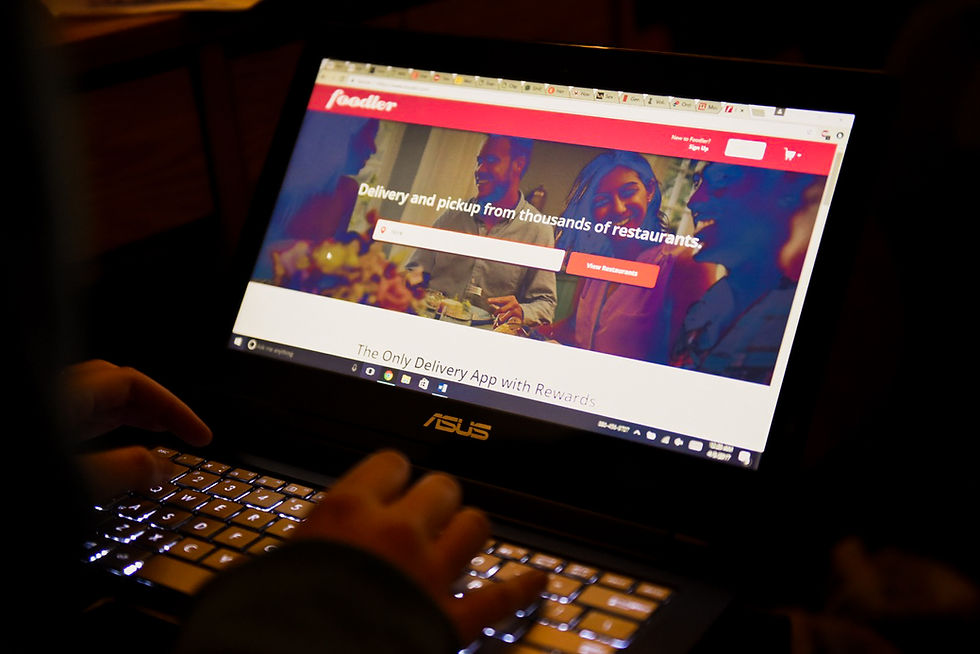Delivery Reinvented
- Site Admin
- Apr 11, 2017
- 3 min read
by Riley Sugarman
Photography by Maisie Mansfield

In an age when anything can be ordered at the touch of a button, food delivery is no exception.
“To say that recent capital inflows in the food-ordering space have been growing rapidly wouldn’t be doing the current funding environment justice,” said Eric Kim, CEO of RushOrder, an L.A-based mobile food ordering startup, in an interview with techcrunch.com.
Kim said about 13 percent of the takeout and delivery market was online in 2015. However, there was soon a clear shift to online delivery. McKinsey & Company, a technology-consulting firm, said that by November 2016, online food delivery had reached 30 percent of the total food-delivery market. That number is expected to grow to 65 percent.
According to McKinsey & Company, there are two types of online food delivery platforms: aggregators and new delivery. Aggregators essentially allow users to order from the website or app, and the restaurant handles the actual delivery. New delivery apps and websites both order from the restaurants and deliver to the user; the latter are currently taking the market by storm.
“[New delivery] allows them to open a new segment of the restaurant market to home delivery: higher-end restaurants that traditionally did not deliver,” said Carsten Hirschberg, a spokesperson for McKinsey. “Despite the higher costs of maintaining delivery vehicles and drivers, the new delivery players achieve [profitability] margins of more than 30 percent.”
Aggregators and new delivery players do not compete but rather attract different demographics. New delivery only poses a potential threat to aggregators because of its cost-efficiency, but both remain successful.
New delivery apps such as Grub Hub, UberEats and Postmates are especially popular among college students because of the convenience.

Natasha Holden (COM ’18) began using food delivery apps during her freshman year of college.
“I didn’t have a kitchen back then and got so tired of the dining hall food,” Holden said. “I started experimenting with food delivery apps until I was basically addicted.”
“I usually order through delivery apps five or six days a week,” Holden said. “I leave for class early and get home late, so I’m too tired to cook at that point and it’s so much easier.”
Clare Bornstein (COM ’17, CAS ’17) uses food delivery apps at least once a week.
“I usually use Foodler because it’s generally faster than other apps I’ve tried and has more restaurant options,” she said.
While Bornstein does not use food delivery apps frequently, they are sometimes her best and only option because of her class and homework schedule.
“I usually use it during late nights and all-nighters because I don’t have time to make food when I’m studying,” said Bornstein.
Uber recently released a new feature, UberEats, to take advantage of its diverse market demographic. UberEats adds a charge of five dollars to a normal Uber ride, but otherwise functions similarly to other delivery apps. While an extra five dollars seems like a small fee, the overall price of delivery fluctuates according to Uber surge pricing, and some dislike that inconsistency.
Holden tried UberEats for a short time, but quickly switched back to Grub Hub.
“I didn’t like how the prices spiked with the weather and traffic, which is why I prefer Grub Hub since its prices are pretty fixed,” said Holden.
Brianna Shorte (Questrom ’18) also did not like UberEat’s price irregularity.
“It seems like a decent concept, but it makes me question how much the delivery price will surge and how [UberEats] will compare to its competitors,” said Shorte. “There’s no reason why I should pay 40 dollars for a 20-dollar meal because of a surge on Uber prices.”
Some Boston University students still have not tried food delivery apps, even though the apps continue gaining traction across college campuses.
“I’ve never used an app, but I have ordered food online, mostly Dominos, though,” Rachel Litton (SAR ’18) said.
However, Litton said she might join the delivery app craze the next time she craves takeout.
“I’m all about good hours, cheap delivery and fast turnout time to prevent food borne illness, but that’s just my inner public health nerd speaking,” said Litton.